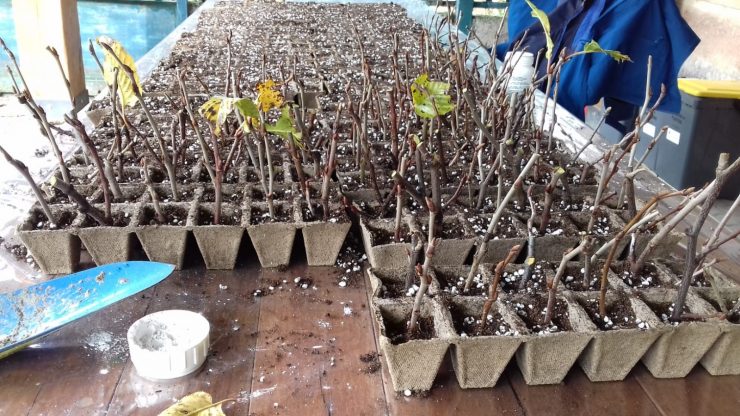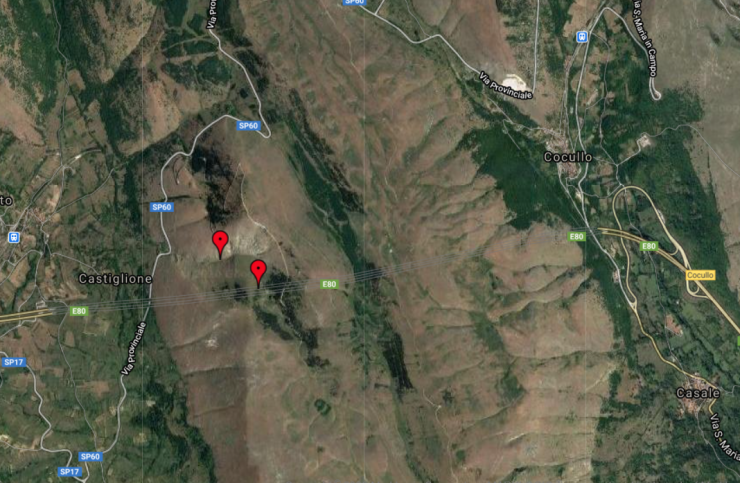Enhancement of habitat suitability for the Marsican brown bear to facilitate its dispersal in two wildlife corridors, connecting the Abruzzo, Lazio and Molise National Park (ALMNP) to the Sirente Velino Regional Park (SVRP) north and the Majella National Park (MNP) east. Through the reproduction and bedding out of native fruit plants, which are part of the bear’s diet, from cuttings, seeds, and dissemination of seed bombs.
1. Presentation
The Apennines brown bear is a critically endangered subspecies (IUCN Red List of Italy). It is restricted to the central Apennines of Italy with a suitable range of approximately 1,800 km2. The ALMNP hosts a high-density population of 3-4 bears per 100 km2 and has most likely reached carrying capacity. Thus, it is critical that bear dispersal is facilitated to reduce the impact of in-breeding and allow bears to expand their range.
It is urgent for action to be taken to expand the population range and establish a viable metapopulation that includes suitable areas outside the ALMNP. The most peripheral areas of the range have very few bears, and only three documented known reproductive females. These areas are potentially suitable, but range expansion is limited by human disturbance and human-induced mortality, which is the largest impediment to bear re-colonization.
This project will be the first in specifically targeting bear-range expansion by facilitating co-existence in three previously identified bear expansion corridors, reducing human-induced mortality, and increasing support for bear conservation. The targeted corridors connect the ALMNP buffer zone (1) north to the Sirente Velino Regional Park (SVRP); (2) east to Majella National Park (MNP) through Mount Genzana. Together, these corridors include six Natura 2000 sites and are crucial to the survival of the Apennines brown bear allowing isolated individuals to be functionally linked and significantly expanding favourable habitat for bears and many other species.
These two identified passage-areas prove to be of fundamental importance as ecological corridors for the Marsican brown bear and other mammals, enabling them to reach suitable areas and helping them to avoid crossing motorways and railway lines. Today many of these areas, although geographically ideal to increase connectivity between three large, protected areas (ALMNP, SVRP and MNP), prove to be devoid of food resources and possibilities of shelter specifically for the Marsican brown bear. This is because, especially in the first half of 1900s, much of their vegetation cover was lost due to intensive cattle grazing, deforestations and fires. So, enhancing refuge areas and food availability is a strategy to increase their use by wildlife.
Since 2016, Salviamo l’Orso has been working in these corridors in the scope of the projects “Wildlife corridors” and “The cutting edge of conservation”, monitoring the frequentation and passage of the local fauna. This initiative will complement the effort Salviamo l’Orso has already made with these two projects.
The data recorded by our camera traps show how many species, including the Apennine wolf, strongly use these places as social gathering points.
The density rate of the Marsican brown bear within its core area (ALMNP) is optimal and the only way to enable the expansion and growth of the bear population is to guarantee their safe passages also providing food sources – improving food chains – and shelters.
Continuous studies on the Marsican brown bear have highlighted traffic accidents as a major cause of mortality and therefore the strong impact between fauna and traffic zones, due to habitat fragmentation.
Thanks to the consultancy of Mr. Pietrantonio Costrini, an expert in the sector of fruit plant growing and collaborator of Salviamo l’Orso, it will be possible to reintroduce in these areas native and very resilient plants, thus restoring not only the ancient landscape and vegetative heritage, but also the passage of the local wildlife.
The use of plants such as the Apennine currant (Ribes uva-crispa), the Alpine buckthorn (Rhamnus alpina), the bramble (Rubus ulmifolius) and the cornelian cherry (Cornus mas) will restore the vegetation within these ecological corridors, increasing the trophic resources for the bear thus guaranteeing a greater possibility of expansion.
1.1 Area of intervention
Two wildlife corridors in the Central Apennines of Italy, connecting north (1) the ALMNP to the SVRP and east (2) the Majella National Park (MNP). The project will be set in the municipal territories of Ortona dei Marsi (1) and Pettorano sul Gizio and the local Monte Genzana Alto Gizio Nature Reserve (2).
1.2 Main purpose
Enhance the habitat of the Marsican brown bear and facilitate its use and frequentation of two wildlife corridors connecting critical conservation areas for its persistence by improving food availability and refuge areas with the increase of native fruit plants.
1.2.1 Strategies
1. Production of new fruit plants from cuttings in a nursery to be located in the Association’s headquarters in Gioia de Marsi.
2. Bedding out of the plants from cuttings and dissemination of “seed bombs”, made up of peat, clay, seeds, and eco-friendly fertilizers.
3. Monitoring of the project effectiveness to scale it up and replicate to new areas.
1.2.2 Tactics
Please consider the tactics listed below in relation with the relative strategy as they describe how we intend to achieve them:
1a. Survey and analysis of the project areas for identifying species and number of plants for a sustainable reintroduction
1b. Reproduction in a nursery, through cuttings, of selected fruit tree and shrub species thanks to rooting hormones. The cuttings will be taken during the autumn of 2019, when the plant is quiescent, and kept in a nursery for a year to allow the root system to develop properly and increase the possibility of survival of the plant. To avoid the plants from suffering due to the change in pH, in addition to the altitudinal shock, the soil will be taken directly from the place where the cuttings will be subsequently implanted.
2a. The rooted cuttings will be planted in the autumn 2020 to ensure a sufficient water supply, typical of the autumn season, necessary for their survival in the first couple of months after transplantation.
2b. The association volunteers will take care of the nursery, planting rooted cuttings and dissemination of seed bombs. Seed bombs, consisting of a seed enveloped in a shell made of peat, clay, and eco-friendly fertilizer mixtures, will be disseminated on the ground starting from autumn 2019.
3a. From the very beginning of the project, the volunteers will carry out regular monitoring of the plant growth, create and regularly update a dedicated database.
3b. Carry on regular monitoring of the signs of presence of the bear through direct observations and camera traps.
3c. Target this activity on the areas where fruit sources will be provided by the project.
1.3 Clear agenda
The project will be financially undertaken in one year (2019-2020), while the outcomes will be measurable from 2020:
| Action | Month / Year |
|---|---|
| Technical advice about cuttings and seed collection | August 2019 – November 2020 |
| Production of cuttings, seeds and collection of soil | August – November 2019 |
| “Seed bombs” production and dissemination | September – November 2019 |
| Nursery construction and cutting grow monitoring | August 2019 – November 2020 |
| Planting plants reproduced by cutting | October – November 2020 |
| Final report to Patagonia | November 2020 |
| Verification of rooting of plants reproduced by cutting and “seed bombs” Verification of signs of presence of bear in corridors area | From March – September 2021 |
1.4 Budget
The estimated budget proposal for “Bear green connection” is USD 8,250, with the sum of USD 7,100 required from Patagonia.
Reports
1.1 Survey and analysis of the project areas for identifying species and number of plants for a sustainable reintroduction
In the period August-September 2019, SLO’s volunteers monitored the wildlife corridors (Ph. 1) connecting the Abruzzo, Lazio and Molise National Park (ALMNP) to the Sirente Velino Regional Park (SVRP) north and the Majella National Park (MNP) east. They chose an area in the municipality of Ortona dei Marsi, in the corridor ALMNP-SVRP where to focus the interventions. Between September and November 2019, under the supervision of SLO’s botanical consultant, PhD Pietrantonio Costrini, they collected large amounts of seeds, cuttings and suckers from local trees. In October, the mayor of Ortona dei Marsi released a permission for planting. In November, SLO volunteers made (Ph. 2) and started spreading 300 seed bombs (Photos 3, 4) – Cornus mas seeds enveloped in a shell made of peat, clay and eco-friendly fertilizer mixtures – and produce cuttings. Along with the seed bombs, also 300 acorns of Quercus pubescens and Quercus petrae were sown as the altitude and the exposition to the sun were considered favourable by the botanical consultant.


1.2. Reproduction in a nursery, through cuttings, of the selected fruit tree and shrub species thanks to rooting hormones
In September-November 2019, 800 cuttings were taken by quiescent plants of Malus sylvatica, Cornus mas, Prunus domestica and Rhamnus alpina, and kept in a nursery for a year to allow the root system to develop properly and increase the possibility of survival of the plants. Rooting hormone was added to facilitate this process. To avoid that the plants, in addition to the altitudinal shock, suffered due to the change in pH, the soil was taken directly from the place where the cuttings had to be implanted later on.
However, because of the COVID-19 lockdown in March-May 2020, the volunteers could not water the cuttings regularly and 30% of them did not revive, also due to an unexpected winter drought likely connected to the ongoing climate change.
2.1. Transplantation of the rooted cuttings
The rooted cuttings were planted in the autumn 2020 to ensure a sufficient water supply, typical of the season, necessary for their survival in the first months after transplantation. 100 suckers of Malus sylvatica were also planted showing a great vitality.
However, the choice not to use plastic tubes to shelter the trees and preserve the landscape’s integrity caused a loss of trees (about 50%) due to deer grazing and debarking.
For this reason, SLO decided to buy 100 trees to replace those lost, choosing Rhamnus alpina, which is a species more difficult to reproduce through cuttings, and is adapted to grow on cliffs and outcrops where the presence of herbivores is made more difficult by steep and hard terrain. Moreover, the berries produced by these shrubs are a fundamental part of the bear’s diet in August-September, influencing the movements and foraging behaviour of bears.



2.2. Creation and maintenance of a nursery
The association volunteers set up and maintained a nursery in which the cuttings rooted and a large number of seed bombs were prepared. Unfortunately, COVID-19 restrictions limited the volunteers’ access to the nursery in the spring 2020 and this harmed some plants. Anyway, from May 2020 the nursery has been operating again. SLO’s volunteers are committed to carry on this action on their own also after the ending of this start-up grant from Patagonia.
3.1 Monitoring of the project effectiveness to scale it up and replicate to new areas.
From the very beginning of the project, the volunteers carried out regular monitoring of the plants’ growth and creation and update of a dedicated database. Transplantation and seed bombing occurred in two main areas (Map 1).In June 2020, the cuttings and the suckers planted in these areas adapted very well and bore leaves. Unfortunately, in the summertime, maybe to counter the scarcity of fresh grass, red deer and roe deer seriously damaged the plants. Anyway, this proves their vitality and the success of the plant reproduction methods used. About seed bombs, the results could be more visible in the next years taking into account the vernalisation process and the difficulty to track seedlings in high grass.

3.2 Carry on regular monitoring of the signs of presence of the bear through direct observations and camera traps
The corridor ALMNP-SVRP has been regularly monitored twice a week by three volunteers on average since the beginning of this project. We can notice how signs of presence of bears increased in 2020 with 36 events (Map 3) compared to 2019 (Map 2) when the events were 10. Obviously, at this stage the increase does not depend on the enhancement of food resources as the trees have not borne any fruit yet, but it shows the potential suitability of this area for bear dispersal and persistence.Overturned boulders (Ph. 8) in search of invertebrates and their eggs were the most common bear’s sign of presence. In fact, they were reported in June-July, when fruit is less available. Though, at the end of September 2020, one of the eight project’s camera traps filmed three bears feeding on a cow carcass in the study area. On one occasion, there were two bears together (Ph. 9), probably siblings living together after release from their mother’s care.A third bear, an adult male (Ph. 10), also benefitted from the carcass, which attracted a pack of six wolves (Ph. 11), griffon vultures (Ph. 12) and a golden eagle too (Ph. 13).








3.3 Target monitoring on the areas where fruit resources were provided by the project
A particular effort has been made to monitor the areas where the intervention was focussed. While in the broader area the presence of bears was more evident, in the areas where transplanting and sowing occurred no signs of presence have been so far reported, though this is consistent with the current lack of food resources in late summer-autumn, which this project aims to counter.
4. Conclusions
This initiative significantly contributed to establish a nursery of wild fruit trees in the headquarter of Salviamo l’Orso in Casali d’Aschi giving an opportunity for SLO volunteers to gain experience and develop the proper know-how to carry on this activity independently and with internal funding.
Due to COVID-19 lockdown and competition with natural grazers, some saplings went lost, but SLO now has the proper tools and skills to replace them and achieve the main goal of the project: enhance the habitat of the Marsican brown bear and facilitate its use, frequentation and persistence by improving food availability and refuge areas with the increase of native fruit plants.
Though nature needs time to prove this strategy fully successful, the tactics implemented and the growing presence of bears in the area have shown us the way to make wildlife corridors more functional for this unique species of the Italian central Apennines.
Financial report
| Expenditures(e.g. salaries, rent, supplies) | ||
|---|---|---|
| TOTAL | ||
| Item 1 – GPS Garmin 64st x 5 | ||
| Item 2 – Volunteer insurance | ||
| Item 3 – Biodegradable jars (1,000 pieces) | ||
| Item 4 – Rooting hormone | ||
| Item 5 – Work tools (gloves, cutters x 20 people) | ||
| Item 6 – Clay, soil and eco-friendly fertilizer for “seed bombs” | ||
| Item 7 – Refreshments for volunteers | ||
| Item 8 – Fuel reimbursement | ||
| Item 9 – 8 camera traps for monitoring (including lithium or external batteries) |








